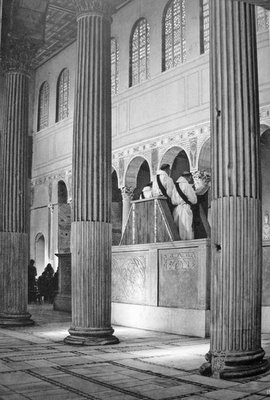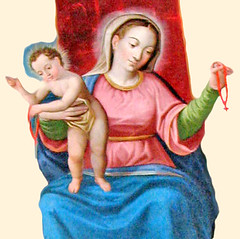Memento, homo, quia pulvis es...
 The Stational churches are churches in Rome where the papal liturgy on certain days of the liturgical year were celebrated. The Pope and his clergy would have processed to the appointed stational church from the Lateran Palace while the Christian faithful would have processed, singing psalms and litanies, from the church of the gathering to the stational church. There they met the Roman Pontiff who would then celebrate the 'conventual' Mass of the City and the world. This processional practice was called "making the station" and is still carried out by some every day in Lent, a practice which is richly indulgenced. Every day, I shall note the Stational church and present some information about it.
The Stational churches are churches in Rome where the papal liturgy on certain days of the liturgical year were celebrated. The Pope and his clergy would have processed to the appointed stational church from the Lateran Palace while the Christian faithful would have processed, singing psalms and litanies, from the church of the gathering to the stational church. There they met the Roman Pontiff who would then celebrate the 'conventual' Mass of the City and the world. This processional practice was called "making the station" and is still carried out by some every day in Lent, a practice which is richly indulgenced. Every day, I shall note the Stational church and present some information about it.Today's Ash Wednesday Mass is held at the stational church of Santa Sabina (shown on left) on the Aventine Hill. This ancient basilica was built in 425 on the former site of the martyr, St Sabina's house. Having been converted by her maidservant, she was beheaded for the faith and secretly buried in the second century. In the fifth-century it was one of the twenty-five parishes of Rome and it was bequeathed to St Dominic and the Order of Preachers by Pope Honorius III in 1221. The Master of the Order, Successor of St Dominic, and his Curia still reside at Sta Sabina and have the care of this ancient church. It is their privilege to receive the Holy Father on this day and celebrate the stational Liturgy of Ash Wednesday with him.

The ashes we receive on Ash Wednesday are a relic of an ancient ceremony referred to in the Roman Pontifical whereby Christians who were guilty of grave faults had to undergo public penance in order to be reconciled to the Church at the Easter festival. Accordingly, the bishop used to bless the sackcloth, which was worn by the penitents as a sign of repentance throughout the forty days of Lent. The penitents were then driven from the church, in imitation of Adam and Eve who were expelled from paradise, while the seven Penitential psalms were sung. They would only be allowed to re-enter the church after Maundy Thursday when they had earned reconciliation by their long Lenten penance and sacramental absolution. The drawing here, which is taken from an 1845 Pontificale Romanum, illustrates their being clothed with sackcloth.
In Rome itself, the penitents presented themselves on Ash Wednesday morning to the Roman Penitentiaries at the various basilicas of the City and received from them a sackcloth strewn with ashes. Having donned this, the penitent then retired to one of Rome's many monasteries to perform the forty days of penance. Our current communal reception of ashes, which is a Scriptural sign of public repentance and sorrow for sins, is a reminder of this ancient ritual, but instead of applying it to one group of sinners, it is applied to all sinners from the Pope to the neophyte. This ritual dates to the 11th-century when Pope Urban VI mandated at the Council of Beneventum (1091) that all the faithful should receive the imposition of ashes; however, the origin of this practice is not Roman but English. It is noteworthy that in the twelfth-century, the ashes were imposed at the church of Santa Anastasia before the Pope and the clergy and faithful mounted the Aventine hill for the Stational Mass at Santa Sabina.
Thomas Merton says that the ashes, acting as a sacramental, "bring the grace of that humility which they signify, they bring also the pardon which we implore by the fact of receiving them." He adds that the ashes "bring at the same time the realization of the horror of sin, and confidence of forgiveness." In this way, they signify the character of Lent which combines compunction for sin with the joy of God's mercy and redemption. As such, Merton notes that "the cross of ashes, traced upon the forehead of each Christian, is not only a reminder of death but inevitably (though tacitly) a pledge of resurrection... the cross is the sign of Christ's victory over death... The declaration that the body must fall temporarily into dust is a challenge to spiritual combat, that our burial may be 'in Christ' and that we may rise with Him to 'live unto God'. The ashes of this Wednesday are not merely a sign of death, but a promise of life to those who do penance... the ashes are clearly a summons to penance, fasting and compunction."
May we who today are signed with ashes be attentive to this call to greater holiness and, with the help of the saints and especially St Sabina, respond generously to the grace of this holy season of Lent.







2 Comments:
Is it just me, or have you added liturgical violet to this blog?!
Sa Sabina's is absolutely beautiful. And the view!!! Sorry, reminiscing...
No, it's not just you...
Watched the Mass at Sta Sabina today on EWTN. It was great.
Post a Comment
<< Home